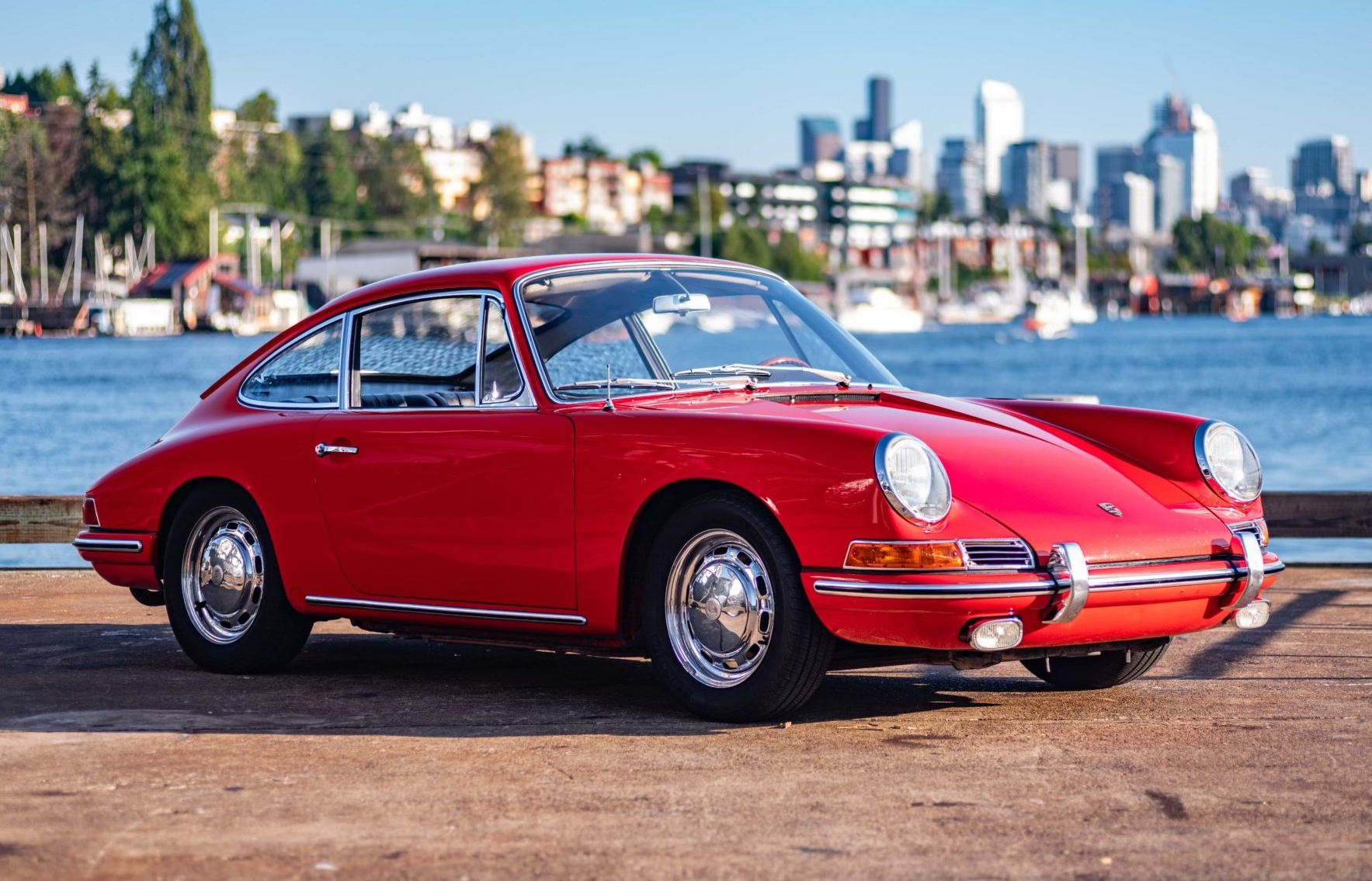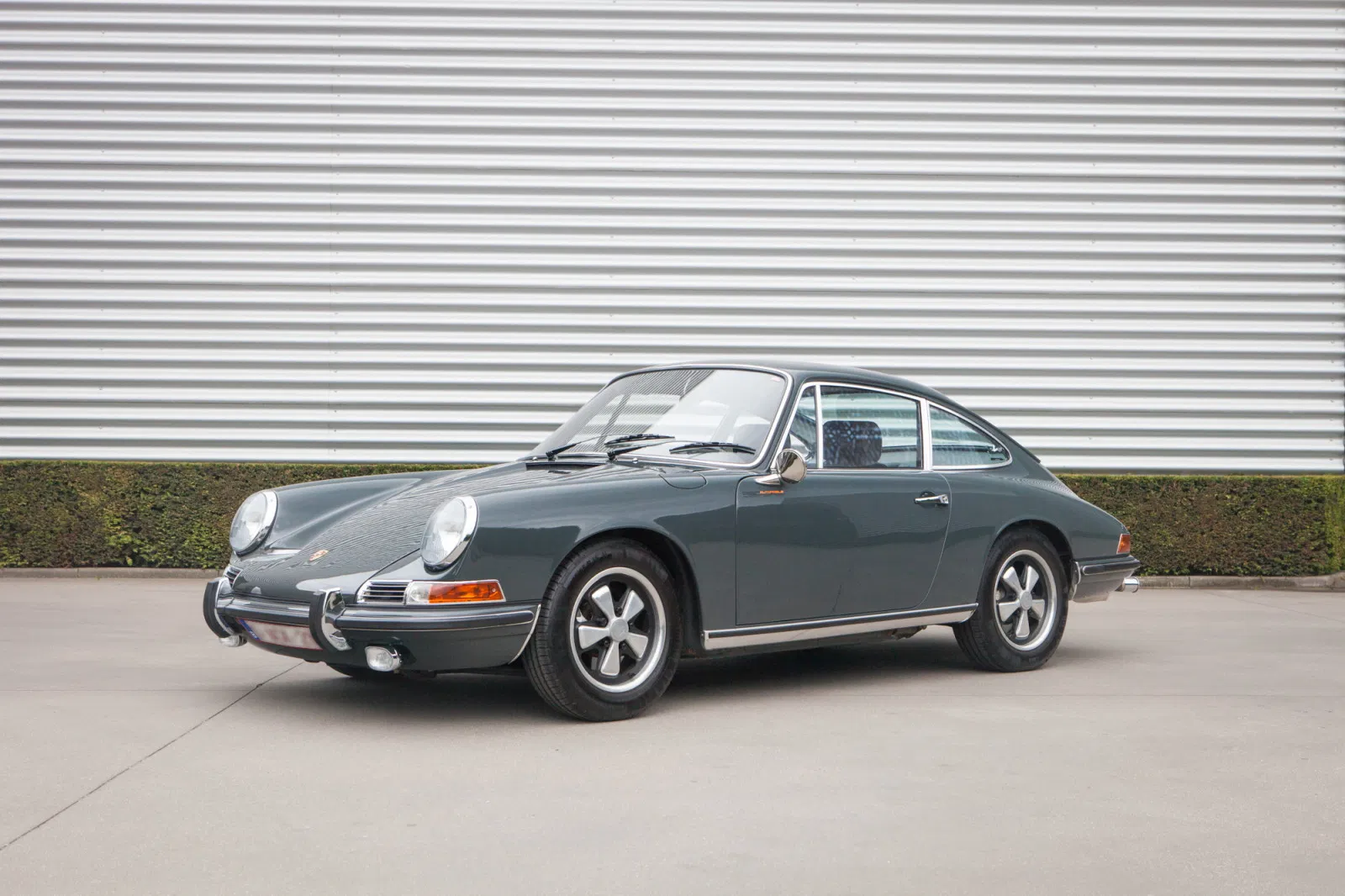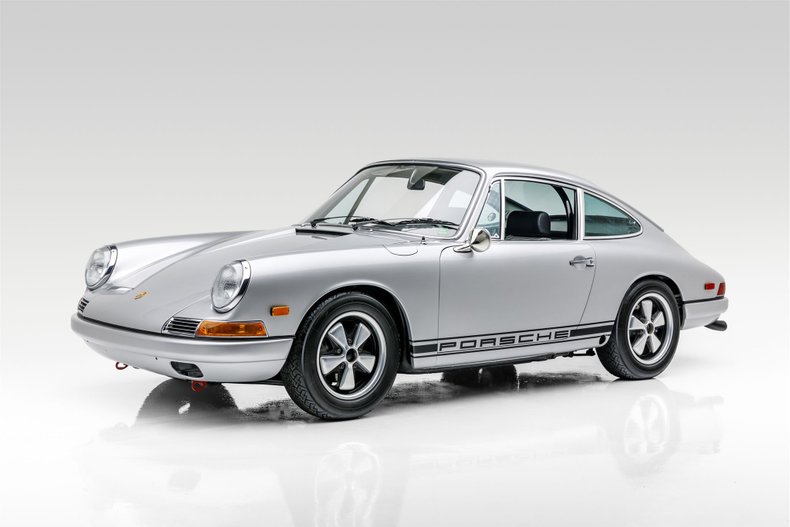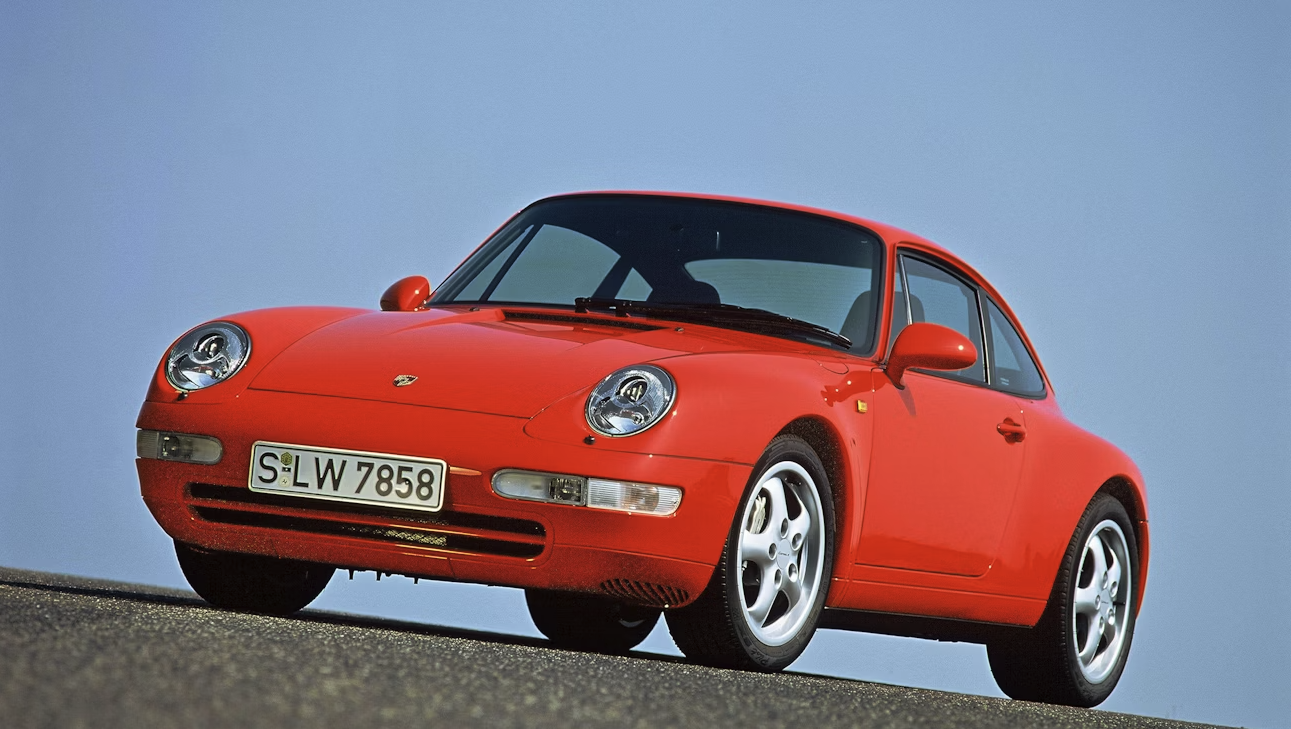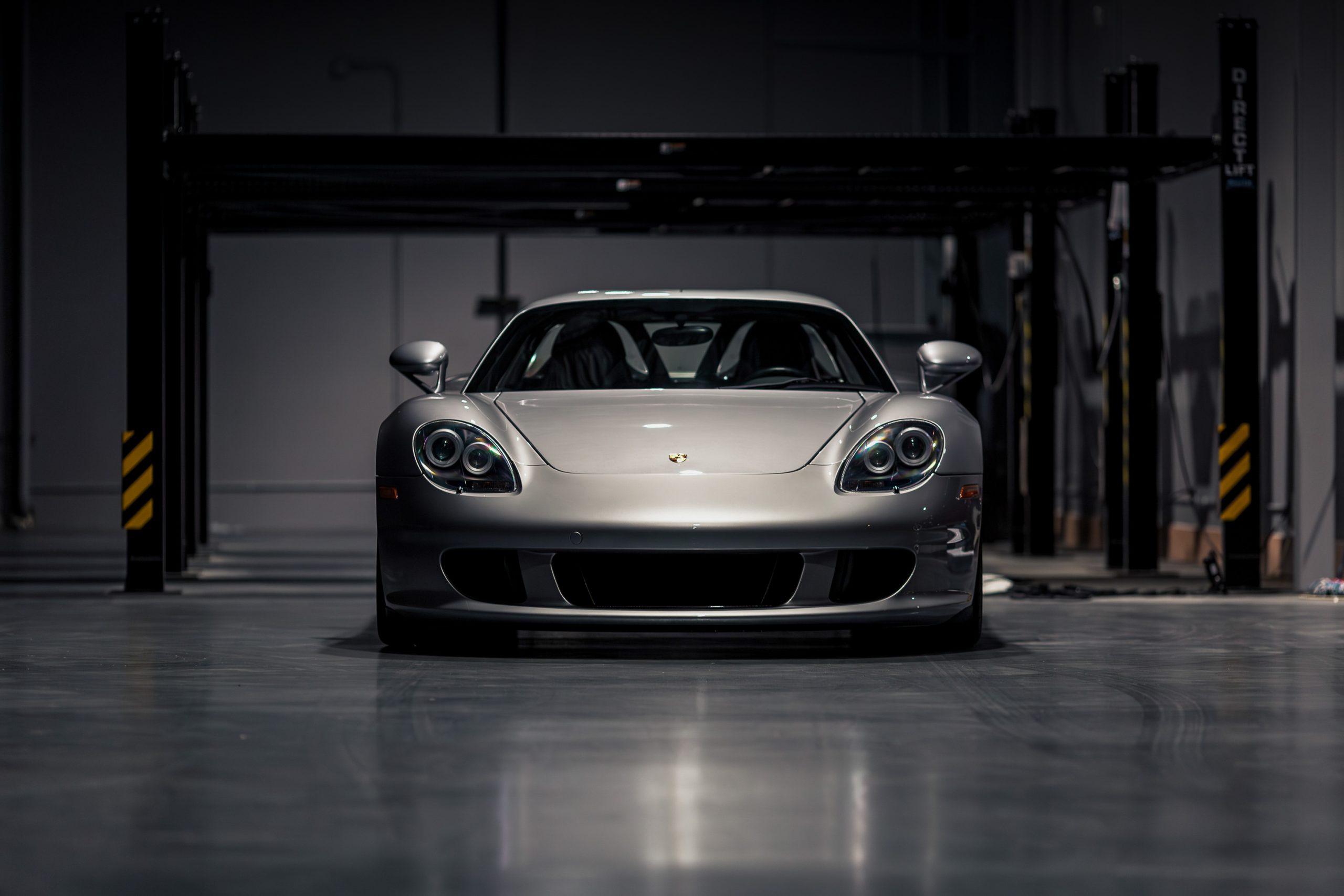Porsche 911 (F-Series) Buyer's Guide
Buying a Classic 1965 - 1973 Porsche 911? Our (Seriously In-Depth) Buyer’s Guide Covers Key Variants, Potential Issues, Market Values, Expert Tips, What To Expect & MUCH More.
The first-generation Porsche 911—often referred to as the F-Series—is where it all began. Produced from 1965 through 1973, this is the era that defined the Porsche 911’s DNA: a lightweight, rear-engine sports car with a flat-six engine, precise steering, and a driving experience that has become the benchmark for sports cars ever since. From the early short-wheelbase (SWB) models to the longer-wheelbase (LWB) cars introduced in 1969, and culminating with the legendary 911S and the Carrera RS 2.7, this generation offers both historical significance and thrilling analog driving.
For collectors, enthusiasts, and purists alike, the F-Series represents the purest form of the 911. It was designed without the burden of emissions or safety regulations that would later influence the model. The earliest models (1965–1968) are incredibly light and mechanical in feel, while the later cars (1969–1973) added more power, refinement, and better handling thanks to the longer wheelbase and engine evolution. Whether you're after a clean and classic 911T, a sportier 911E or 911S, or the holy grail Carrera RS 2.7, there is something in this range to match every dream—and budget.
This Buyer’s Guide dives deep into all the key models, the common issues to watch out for, what makes certain cars more collectible than others, and how to find the right car for your goals. Whether you're a first-time vintage Porsche buyer or a seasoned collector looking to round out your collection, the F-Series 911 is a cornerstone of Porsche history—and a truly special car to own and drive.

Why the 1st generation Porsche 911 (1965 - 1973) is a Unique Classic to Buy
Few vehicles in automotive history carry the kind of cultural and engineering significance that the first-generation Porsche 911 does. Launched in 1964 and refined through 1973, the original 911—often referred to as the F-Series—wasn’t just Porsche’s step into six-cylinder sports cars; it was the genesis of one of the most enduring and beloved performance car legacies in the world. It remains not only a symbol of 1960s and early 1970s sports car innovation but also a benchmark for analog driving purity. If you’re considering a vintage sports car, the 911 F-Series is in a league of its own.
What makes the early 911 so unique is the driving experience. It’s lightweight, mechanically communicative, and visceral in a way that few cars—before or since—have captured. These cars weren’t loaded down by modern safety, emissions, or electronic systems. They offered raw feedback through the steering, unassisted brakes, and that unmistakable howl of an air-cooled flat-six spinning behind you. Even a 911T feels lively and spirited, while the higher-performance 911S or the ultra-rare Carrera RS 2.7 elevate the experience into something genuinely thrilling for seasoned enthusiasts.
From a collector standpoint, the F-Series 911s offer an ideal blend of usability and appreciation potential. They're not so fragile or rare that you can't drive them regularly, yet they have proven to be solid long-term investments—particularly the more desirable variants like the short-wheelbase cars (1965–1968), the 911S, and of course, the Carrera RS 2.7. With parts support from both Porsche Classic and the aftermarket, keeping one running is surprisingly doable for a 50+ year-old car. Plus, there’s a dedicated global community behind the model, offering everything from concours events to vintage racing support.
But perhaps the greatest reason to consider a first-gen 911 is that it's the cornerstone of everything Porsche would become. The silhouette, the driving philosophy, the engineering values—it all started here. Owning an early 911 isn’t just about having a beautiful car in your garage. It’s about owning a foundational piece of Porsche history, a symbol of post-war engineering optimism, and a vehicle that still holds up as an incredibly rewarding machine to drive. If you're looking for a classic that balances heritage, engagement, and long-term desirability, there’s no better place to start than the F-Series 911.
Classic Porsche 911 (F-Series) Models & Variants - A Quick Primer for Potential Buyers On The Variants & Specials To Think About.
We already have ultimate guide to the first generation Porsche 911 so we don't want to repeat everything here. Instead, we will give you a quick primer and summary about the main F-Series 911 variants, some of the core model year changes and we will talk about some special editions worth noting as you think about your potential purchase.
Key Variants & Differences
The first-generation Porsche 911 often referred to as the F-Series or “long-hood” 911s, went through a remarkable evolution during its early years. For collectors, enthusiasts, and first-time vintage Porsche buyers alike, understanding the key variants and differences between them is essential to choosing the right car for your needs, whether that’s spirited weekend driving, concours-level collecting, or something in between.
1965–1968: Short-Wheelbase (SWB) 911s
These are the earliest 911s and are sometimes considered the “purest” by purists and collectors. Built on a 2,211 mm wheelbase, they feature a simpler, lighter construction and a more tail-happy dynamic due to the rear-engine weight bias. Key models include:
1965–1966 911 (2.0L, 130 hp) – The original car with Weber carbs and elegant simplicity. These early cars are highly collectible, especially 1965 “300-series” examples.
1967 911S (2.0L, 160 hp) – The first high-performance 911, featuring forged alloy wheels (Fuchs), upgraded brakes, and improved suspension. Hugely desirable today.
1967–1968 911T and 911L – The “Touring” (T) was an entry-level version, while the “Luxe” (L) replaced the S temporarily in the U.S. due to emissions.
These SWB cars are known for their liveliness and lightweight character. They feel very mechanical and analog but are more demanding to drive at the limit.
1969–1971: Long-Wheelbase (LWB) Evolution and Model Expansion
From 1969 onwards, Porsche increased the wheelbase to 2,268 mm for improved handling balance. This marked the beginning of the LWB era, with new variants and continuous refinement.
911T (2.0L to 2.2L, then 2.4L) – The entry-level model, often carbureted (later fuel-injected), but still plenty fun and nimble. Available in Coupe and Targa body styles.
911E (2.0L to 2.4L) – The mid-range model with mechanical fuel injection (MFI). Known for its torque and smooth delivery; considered one of the best all-around classics.
911S (2.0L to 2.4L) – The top-tier performance version throughout this period, always with MFI and chassis upgrades. Highly desirable and valuable today.
The move to LWB improved high-speed stability and comfort, making these cars more usable and better suited for regular driving, even by modern standards.
1972–1973: Peak of the F-Series and Pre-Impact Bumper Era
These final years of the first-gen 911 are widely regarded as the sweet spot for collectors and drivers. The engines grew to 2.4L across the board, and refinements were made to reliability and creature comforts. Crucially, 1972 brought the unique external oil filler door—a one-year-only feature on the right rear fender.
1972–73 911T – Now with a 2.4L engine producing 140 hp (U.S.) or 130 hp (Euro carbureted). Great driver cars and good value in the market.
1972–73 911E – With 165 hp and strong mid-range torque, this is the hidden gem for those seeking a balance between usability and sportiness.
1972–73 911S – With 190 hp and the most refined version of the MFI flat-six, this is the crown jewel of the regular-production F-Series models.
1973 Carrera RS 2.7
The ultimate first-gen 911 and perhaps the most iconic air-cooled 911 of all time. Built for homologation, the Carrera RS 2.7 featured:
Lightweight construction (especially in the “Lightweight” M471 version)
210 hp 2.7L engine
Stiffer suspension, wider rear track
Iconic “ducktail” spoiler
Values today are well into the six- and even seven-figure range, and it’s a benchmark car in Porsche history. These are blue-chip collectibles.
What Buyers Should Consider
When evaluating F-Series 911s, consider your intent: Are you looking for a fun driver (T or E)? A collector car with strong long-term appreciation (S or RS)? Or something unique like an early short-wheelbase model? Each has distinct characteristics and value propositions.
Short-wheelbase cars are pure, rare, and raw—but more temperamental.
Long-wheelbase 911Es are often the best blend of affordability, performance, and refinement.
911S and RS cars are in a different league in terms of price, but represent the pinnacle of first-gen engineering.
Buy the best example you can afford, and always look for authenticity, rust-free condition, and good documentation.
Model Year Changes (1964-1973)
The first-generation Porsche 911 model year updates were subtle in some years and more dramatic in others.
1964–1965: The Birth of the 911
The Porsche 911 was launched in late 1964 as a 1965 model, replacing the Porsche 356.
Early cars were powered by a 2.0-liter air-cooled flat-six producing 130 hp, paired with a 5-speed manual gearbox.
The design was penned by Ferdinand "Butzi" Porsche, retaining the rear-engine layout but introducing a sleeker, modern silhouette.
These early cars are known as "300-series" cars, and are particularly prized by collectors.
1966: Introduction of the 911S
The 911S (Super) was introduced with 160 hp, lightweight forged Fuchs alloy wheels, and suspension/brake upgrades.
This year also saw the 911 chassis extended for the first time to include a convertible option—the Targa, introduced late in 1966 as a 1967 model.
Targa models came with a removable roof panel and fixed rear glass or optional soft rear window.
1967: The 911T, L, and U.S. Emissions Adjustments
Porsche began to offer model tiers: the 911S remained the top-tier, and the 911T (Touring) was introduced as a lower-cost entry point with 110 hp.
For U.S. markets, the 911L replaced the S temporarily due to emissions restrictions; it retained the S’s trim but had the base 130 hp engine.
The 911R was also introduced as a limited-run lightweight race car (only 20 made).
1968: Final Year for SWB Cars
This was the final year of the Short-Wheelbase (SWB) 911, which measured 2,211 mm between the axles.
All three trims—T, L, and S—were offered, but U.S. cars lost horsepower due to stricter emissions.
Ride and handling characteristics remained very lively, but the short wheelbase made the car twitchy at the limit.
1969: Transition to Long-Wheelbase (LWB)
This year marked a major update: Porsche extended the wheelbase to 2,268 mm, improving high-speed stability.
The 911E (Einspritzung) replaced the L and featured Bosch mechanical fuel injection (MFI), smoother power and 140 hp.
Engine displacement stayed at 2.0 liters, but drivability improved across the range.
This year also marked the introduction of vented disc brakes across the model line.
1970: Engine Size Increased to 2.2 Liters
All 911 variants received a displacement bump to 2.2 liters:
911T: 125 hp (carbureted or MFI depending on market)
911E: 155 hp (MFI)
911S: 180 hp (MFI)
These cars are often considered the sweet spot between early character and increased usability.
1971: Refinements
No major styling changes, but improvements included:
Better oil tank placement
Internal engine upgrades for reliability
Slight interior revisions and material upgrades
This was the last full year before Porsche introduced the most significant changes of the F-Series.
1972: The “Oil Flap” Year
Porsche moved the oil tank inboard, improving weight distribution. This led to the unique external oil filler flap behind the passenger door—a feature exclusive to 1972.
All engines grew to 2.4 liters:
911T: 130 hp
911E: 165 hp
911S: 190 hp
Improved 915 5-speed transmission replaced the older dog-leg 901 gearbox for better shift quality.
These 1972 cars are highly sought after for their performance and one-year-only configuration.
1973: Final Year of the Long-Hood Era
1973 saw minor cosmetic updates (no more external oil flap)
The 911T switched to CIS (Continuous Injection System) in U.S. markets for smoother emissions compliance.
This year also introduced the legendary 911 Carrera RS 2.7 in both Lightweight (M471) and Touring (M472) trims. With 210 hp, flared fenders, and the iconic ducktail spoiler, it became the pinnacle of the early 911 lineup.
Summary for Buyers
Earlier SWB cars (1965–1968) offer the most analog driving experience but require a skilled hand. LWB cars (1969–1973) are more refined and offer higher-performance variants. The '72/'73 (especially the S and RS variants) stand out as our faves.

1st Generation Porsche 911 Market Value & Pricing
When buying a classic Porsche 911, understanding market values and what drives pricing differences is crucial. Unlike more mass-produced classic cars, the 911 has become increasingly rare over the years, with many original examples lost to rust, modifications, or neglect. This means that well-preserved, documented, and rust-free examples are becoming harder to find, making careful research essential for any buyer. Factors such as model type, originality, rust condition, provenance, and special edition status can significantly impact an early generation 911’s market value. Additionally, with the rising popularity of vintage Porsches, the classic 911 is a respected classic with strong investment potential so lots of buyers are looking at them to add to their collections.
What Are Classic Porsche 911s Worth?
The price of a Porsche 911 from the first generation F-Series varies widely based on condition, originality, model variant, and desirability. Below is a breakdown of pricing into five categories—ranging from restoration projects to concours-level examples—along with insight into what buyers can expect in each bracket.
Project Cars/Non-Runners
$40,000 - $90,000
At the entry-level end of the market, you'll find first-gen 911s in project or non-running condition, typically priced between $40,000 and $90,000. These cars often suffer from severe rust, missing parts, and incorrect engines or transmissions. Many were victims of poor storage, neglect, or botched restoration attempts decades ago. They can be appealing to hands-on enthusiasts or restoration shops looking to build value, but buyers should approach with caution. Restoration costs can easily surpass six figures.
Driver-Quality Examples
$90,000 - $150,000
Moving up the ladder, you’ll find "driver-quality" 911s—cars that are mechanically sound, generally rust-free, and often partially restored or cosmetically refreshed. These are not garage queens, but honest, usable cars that still retain much of their original charm. They may have seen an engine rebuild, a repaint, or interior retrimming at some point. Prices in this tier typically range from $90,000 to $150,000 depending on variant, originality, and service history. They’re ideal for enthusiasts who want to drive and enjoy.
Quality, Well-Maintained Originals
$150,000 - $250,000
This bracket includes the sweet spot for many buyers—cars that are largely original or properly restored, matching numbers, with known provenance and strong docs. You’ll see well-kept 911Ts, 911Es, and occasionally a well-priced 911S in this tier. These cars typically need nothing and can be driven or shown with pride. Values here run from $150,000 to $250,000, and they represent the kind of car most collectors or discerning drivers seek: cosmetically sharp, mechanically dialed-in, and with enough character to reflect the era. Competition for these examples remains strong.
Collector-Grade & Rare Variants
$250,000 - $400,000
Above the well-kept drivers lie collector-grade examples—cars with exceptional originality or restoration quality, rare specifications, and full matching-numbers drivetrains. This tier includes early short-wheelbase (SWB) 911s, low-mileage 911Ss, or uncommon factory options and colors that boost desirability. These cars are typically sold through top-tier dealers or auctions and are priced accordingly—$250,000 to well north of $400,000 depending on provenance and rarity. Buyers here are generally collectors or investors, and the emphasis is on condition, documentation, and long-term value.
Top-Tier & Blue-Chip Collectibles
$400,000 - $1 million+
At the very top sit the unicorns—special cars like the 911 Carrera RS 2.7, ultra-low mileage early cars (especially 1964–1965 builds), or examples with factory race pedigree or ownership provenance. These cars are few and far between and have reached valuations above $1 million at auction in exceptional cases. For example, a well-preserved or perfectly restored 1973 RS 2.7 Lightweight or Touring can command $600,000 to $1,000,000+, depending on market timing. These are investment-grade assets and, for many, pieces of Porsche history, appreciated as much for their rarity.
Factors That Affect Value
When evaluating the value of a first-generation Porsche 911 (1965–1973), several key factors come into play. These classic air-cooled icons have become blue-chip collectibles, but the pricing spectrum is wide. Whether you’re looking at a short-wheelbase 911, a 911T, E, or S, or a rare variant like the Carrera RS 2.7, these are the core factors that impact their market value:
1. Model & Variant (T, E, S, RS, etc.)
Perhaps the single most important driver of value is the specific model designation. Porsche produced several variants of the 911 during this period:
911T was the entry-level model
911E featured mechanical fuel injection and refined trim.
911S performance flagship, more power, better suspension, and trim upgrades.
911 Carrera RS 2.7 is in a class of its own, commanding prices 3–10x those of a base 911T depending on spec.
Higher trim levels, more powerful engines, and motorsport pedigree contribute significantly to value.
2. Originality & Matching Numbers
Originality is crucial in the vintage Porsche market. Cars with matching numbers (engine, transmission, and chassis), factory color combinations, and original interiors are significantly more valuable. A car that retains its factory mechanical fuel injection system (MFI) or original 2.0L or 2.2L engine will command more than one that's been swapped or modified.
Restorations done with attention to factory-correct details—paint codes, upholstery materials, trim, decals—are also valued higher than restomods or non-period-correct builds.
3. Condition (Bodywork, Mechanical, Interior)
Condition plays a major role in pricing across the board:
Rust is the most dreaded issue—particularly around the suspension pan, battery tray, rocker panels, and rear seats.
Mechanical condition—engine compression, transmission synchros, brakes, and suspension—also affects value. A freshly rebuilt engine can add significant appeal.
Interior originality, including correct gauges, dash, and seats, matters to collectors.
Paint and body quality—a high-quality repaint in the original color is acceptable, but a color change or poor paintwork will impact price.
4. Documentation & Provenance
Cars with comprehensive documentation—service records, ownership history, Kardex/COA (Certificate of Authenticity), restoration invoices, and even old photos—are much more attractive. A well-documented car tells a verifiable story, reassuring buyers and often justifying a premium. Provenance also matters: cars previously owned by notable collectors, raced in period, or cool backstory command premiums.
5. Rarity, Color & Factory Options
Production numbers vary by year and variant. Early short-wheelbase 911s (1965–1968) are rarer and thus often more valuable. Certain model years—such as the 1973 911S—are viewed as the high-water mark for pre-impact bumper 911s.
Rare and period-specific colors like Signal Yellow, Irish Green, or Tangerine can boost appeal and price. Factory options like sunroofs, sport seats, Fuchs wheels, limited-slip differentials, or air-con can drive value, especially when documented.
6. Market Trends & Auction History
The vintage Porsche market is sensitive to collector trends and we have seen periods of craziness. Investment-grade 911s tend to hold their value well whereas restoration candidates or modified examples fluctuate more with market confidence.
Investment Potential
When we look at the investment potential of the early Porsche 911 we’re talking about more than just classic car ownership.
We’re talking about owning a piece of automotive history, with very real upside for those who choose wisely. Here’s what makes these cars worth considering from an investment standpoint, and which specific models stand out.
First, the F‑Series 911 occupies a place of unique heritage. It lays the foundation for everything the 911 would become—lightweight air‑cooled flat‑six, iconic silhouette, motorsport DNA. That alone gives it durable appeal.
Over time the market has increasingly recognised that heritage: for example, auction results show early 911s fetching strong numbers. The rarity of truly original, matching‑numbers examples in excellent condition means that scarcity already boosts value—especially for variants at the top of the desirability pyramid.
Over time the market has increasingly recognised that heritage: for example, auction results show early 911s fetching strong numbers. The rarity of truly original, matching‑numbers examples in excellent condition means that scarcity already boosts value—especially for variants at the top of the desirability pyramid.
Second, some specific models from this era have shown particularly strong investment returns. The one that often gets cited is the Porsche 911 Carrera RS 2.7 (1973)—a homologation‑derived lightweight performance icon. One article noted that in 2004 a RS 2.7 could be bought for around US$100,000, and by one later point the value had approached US$800,000.
That sort of gain underscores how rarer variants, especially those with motorsport lineage, correct provenance, and limited production, tend to appreciate strongly. Other variants such as early short‑wheelbase (1965–1968) 911 S, or matching‑numbers 911E or 911S in original trim, also garner attention from collectors and thus benefit from better value retention (and upside) compared to more common or modified examples.
That said, it’s important to stress that investing in an early 911 isn’t guaranteed profit. Several caveats apply. Condition, originality, documentation and variant specification all matter—poor condition or heavily modified cars rarely track the upside of pristine, matching‑numbers cars. As one experienced owner forum contributor put it, “It’s a terrible gamble … you’re not going to make any money … once you factor maintenance and insurance, you’ll be in the red overall.”
So, for real investment potential you’ll want to focus on cars that tick the right boxes: rare variant, matching numbers, fully documented history, minimal corrosion, correct specification.
In summary: the first‑generation Porsche 911 offers very real investment potential—particularly for the rarer, top‑spec models. But the value comes from selectivity, patience, and condition.
If you pick wisely, you may enjoy both the emotional reward of driving a historic sports car and the financial upside of owning a piece of Porsche history.
Recent 1st Generation Porsche 911 (1965-1973) Values & Market Sales Trends
Below, our friends at Classic.com chart recent sales and trends in the early Porsche 911 market. Below we have shown charts and sales trends for the SWB and LWB 911s, but you can get more detail and variant breakdowns directly on their site.
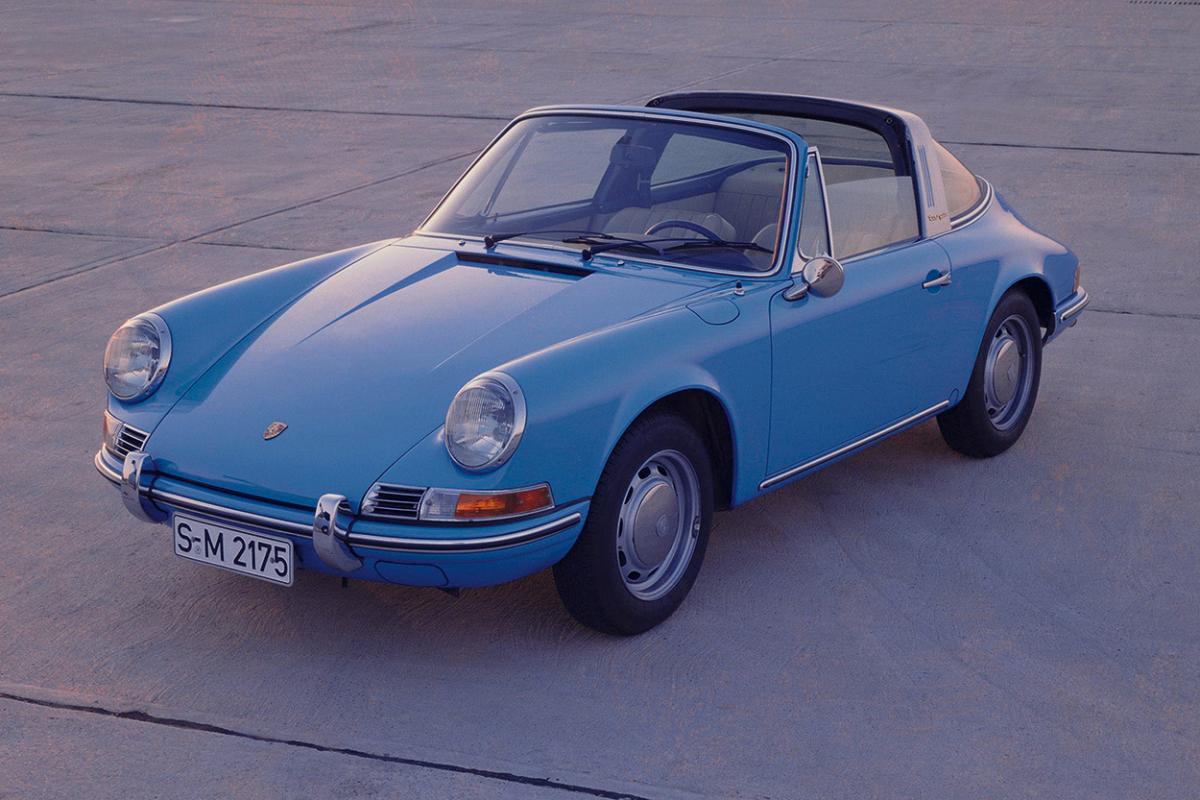
1965 - 1973 Porsche 911 (1st Gen) Driving Experience & What to Expect
Driving a first-generation Porsche 911 is not like piloting a modern sports car. It’s raw, mechanical, deeply analog—and for many enthusiasts, that’s exactly what makes it so special. From the sound and feel of the air-cooled flat-six to the directness of the unassisted steering, the experience is immersive and emotionally charged. But it also requires respect, especially for drivers used to the stability and refinement of modern performance cars.
The early 911 is famously rear-engined with a rear-biased weight distribution. This configuration delivers unique handling characteristics—light steering, incredible traction out of corners, and a driving dynamic that rewards smooth, committed inputs. But it also comes with a learning curve. The short-wheelbase models (1965–1968) in particular are known for their “pendulum” effect, where sudden throttle lift-off mid-corner can lead to oversteer. Later long-wheelbase cars (from 1969 onwards) dialed this back, making the car more predictable and better balanced.
There’s no power steering, no electronic nannies. You feel everything through the chassis—bumps, grip levels, the flex of the car under hard cornering. The steering is alive in your hands, and even though grip levels are lower by modern standards, the feedback and involvement are on another level entirely.
Depending on the year and model, power ranges from around 130 hp (early 2.0-liter cars) to 190 hp (1973 911S 2.4-liter). That may sound modest today, but keep in mind these cars weigh under 2,400 pounds. A 911S from the early ’70s can sprint from 0–60 mph in the low 6-second range—not slow even by current standards.
Where modern cars isolate you from sensation, the early 911 demands your attention. Engine sounds echo in the cabin, gear shifts require precise timing (and often a double-clutch), and braking power—while decent for the era—requires planning ahead. It’s a car that makes you earn your speed, which is part of its timeless charm.
Could you drive a 1st-gen 911 every day? Technically, yes—but it wouldn’t be ideal. These cars were made when creature comforts were minimal. Heating is rudimentary. There’s no air conditioning in most models, and cabin noise is significant. Combine that with vintage ergonomics, and you’re looking at a car better suited for weekend drives or occasional commutes than modern daily duty.
That said, they are generally reliable when well-maintained, and the mechanical simplicity (no electronics to fail) is actually a virtue for long-term ownership. Some enthusiasts do use them regularly—but most keep them as cherished drivers for special occasions, scenic roads, or classic rally events.
Owning and driving a 1st-generation Porsche 911 is about connecting with the roots of the brand—and with a bygone era of sports car design. It’s not about lap times or infotainment systems; it’s about the purity of the experience. If you’re coming from modern Porsches or other high-performance machines, you may find the early 911 initially underwhelming in power—but deeply rewarding in involvement.
Buy the best example you can afford, ideally one with a known history, matching numbers, and a documented service record. Whether it’s a pristine 911S or a lightly patina’d 911T, these cars aren’t just vehicles—they’re mechanical time capsules. And once you learn how to drive one properly, you’ll understand why they’re still adored by purists the world over.
Getting Real - Costs to Own & Maintenance
Owning and maintaining a first‑generation Porsche 911 is wonderfully rewarding—but it also demands planning, budget, and understanding of vintage car ownership. Because these cars are vintage, air‑cooled, and increasingly collectible, the costs can vary widely depending on condition, usage, and how “original” they are. Below is our breakdown of what you should expect for ownership costs, maintenance, parts availability, and insurance for these early 911s.
Maintenance & Ownership Costs
For well‑maintained and regularly driven examples, many sources estimate annual running costs (excluding major restorations) might range from £ 1,000–£ 3,000 per year in the U.K. (roughly US $1,300–$4,000) if the car is used moderately (2,000–4,000 miles per year). Major service jobs—such as engine tuning, major mechanical refreshes or body work—will of course raise the numbers significantly. For example, one forum owner shared:
“Over the past 3 years I have put approximately $10K USD into it … including a trans rebuild.”
That underscores that big bills will come, especially for older or higher‑mileage cars.
Parts availability for these 911s is relatively good—thanks to the enduring popularity of this era, many aftermarket and NOS parts exist. But because the cars are old, labour and specialist knowledge become significant cost drivers. A mechanical overhaul—especially for a badly neglected car—could run many thousands of dollars or pounds. One buyer‑guide advises that a major overhaul can cost “£ 1,000–£ 3,000” (~US $1,300–$4,000) in some cases—but that’s for smaller jobs, not full restorations.
Insurance, Usage & Up‑Front Budget Considerations
Insurance costs for a vintage car like a 1965–73 911 will depend heavily on your region, how often you drive it, condition, and whether the car is classified as a “classic” with limited use. While exact numbers for that specific generation aren’t always published, one summary of “classic 911” ownership suggested that full‑coverage insurance could add £400–£800 per year in the U.K.—though that is a very rough baseline. Because many first‑gen 911s sit in the “investor” or “weekend driver” category, many owners choose limited mileage policies, stored‑vehicle status, or event‑only use, which helps control insurance and running costs.
Also emphasised by experts is that early 911s are not “cheap cars” just because they are old. One site notes:
Those ‘bargain’ classic 911s you see for sale often have something wrong with them.”
So budget accordingly—not only for routine upkeep, but also for those unexpected costs: engine out services, rust repair, drivetrain rebuilds, etc.
Final Take‑Away for Prospective Buyers
If you buy a well‑sorted, documented first‑gen 911, expect manageable annual running costs—say US $2,000–4,000/year in moderate use without major restoration. But if you pick a car needing work, or you plan to drive it a lot or use it at events, budget significantly more—US $5,000+ years or occasional large bills (US $10,000+) should be factored in.
Key to keeping costs under control: choose one with a strong maintenance history, minimal rust, and someone who understands these vintage Porsches. If you’re buying a “restoration candidate”, add a large contingence fund. In return, you get one of the most iconic sports cars ever built—a piece of automotive history that drives beautifully, holds its value, and delivers driving reward every time you drive it.
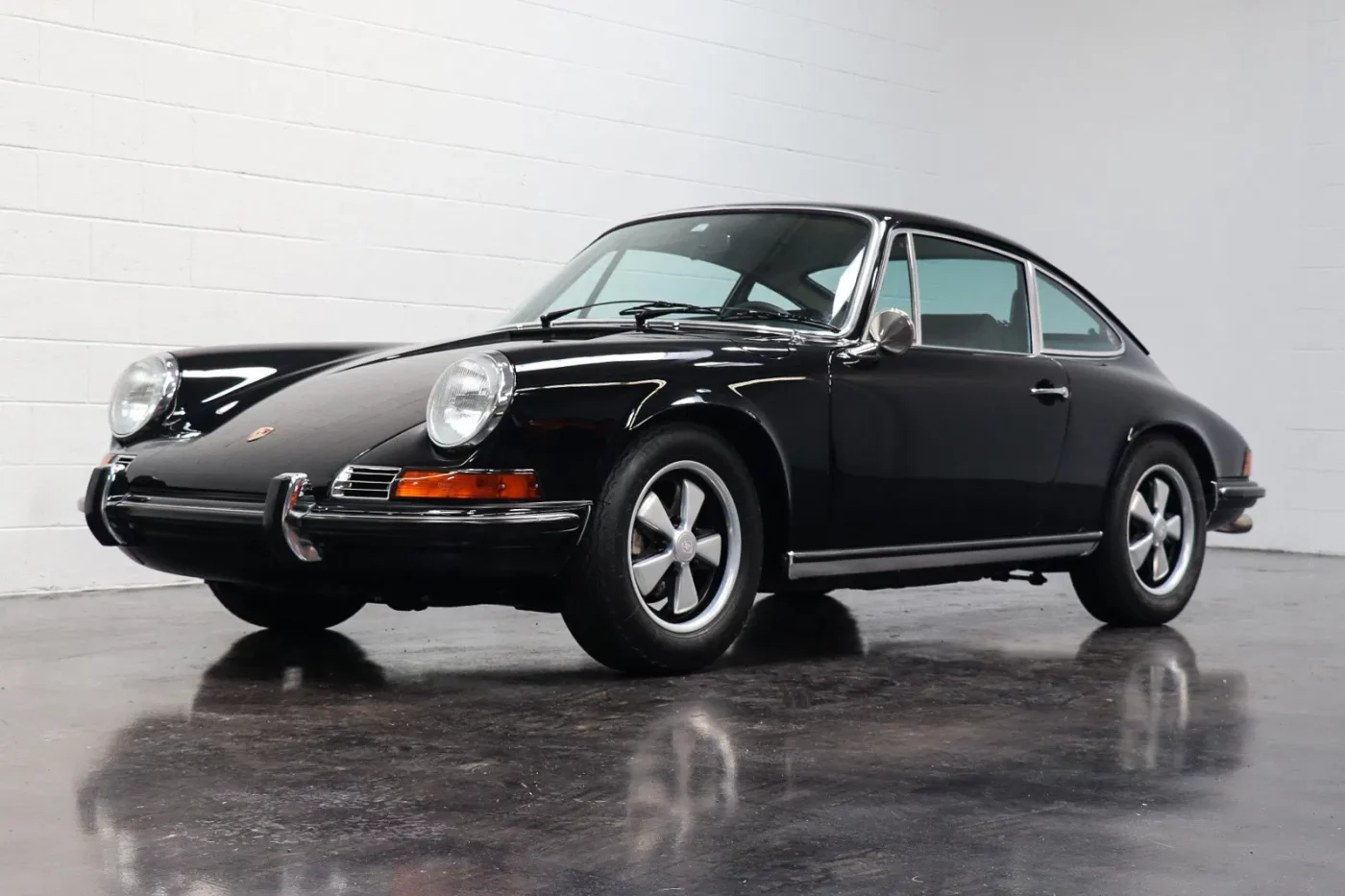
Other Key Buying Considerations
Ensuring Performance, Authenticity, and Long-Term Enjoyment
When buying a first-generation Porsche 911 (1965–1973), there are several key considerations beyond the obvious factors like price, condition, and mileage. These early 911s are valuable collector items and also engaging driver’s cars—so buyers need to weigh originality, provenance, restoration quality, and intended use carefully. Below are the essential considerations every prospective buyer should think through before taking the plunge:
Authenticity & Matching Numbers
Originality has a massive impact on value. Collectors strongly prefer cars with matching numbers—meaning the original engine and transmission that left the factory are still present. Porsche’s Kardex or Certificate of Authenticity (COA) can help verify factory specs. Non-original engines or gearboxes aren’t necessarily a dealbreaker, especially on drivers—but they significantly affect value, especially for investment-grade examples like early short-wheelbase cars, S models, or early 911T/R builds. Also look at the originality of paint colors, trim, wheels, and interiors. A car with original color combinations and factory options (sunroof, sport seats, rare interior materials) is worth more than one that’s been heavily modified or “restored” with incorrect parts.
Documentation & Ownership History
A well-documented history is essential, especially for high-value examples. Look for service records, ownership history, restoration invoices, and historical photos. Long-term ownership—particularly with careful stewardship—is a positive sign. Restoration history should include clear documentation of who did the work, when, and with what quality of parts and techniques. Incomplete paperwork and missing gaps in the car’s life story may raise red flags and reduce resale value.
Rust and Structural Integrity
Rust is the number one enemy of early 911s. These cars were not galvanized until 1976, so even well-maintained examples can have rust in critical areas like the floors, torsion tube, suspension pickup points, battery box, and inner fenders. Cosmetic rust is one thing—but structural corrosion can be extremely expensive to repair. Always consider a pre-purchase inspection (PPI) from a classic Porsche specialist to evaluate rust-prone areas and bodywork.
Restoration Quality vs. Patina
There’s a growing appreciation for unrestored or “preservation” cars, especially those with original paint, interiors, or even mechanical wear that tells a story. In contrast, a poorly done restoration—especially with incorrect parts or dubious metalwork—can hide major problems. A high-quality restoration, properly documented and executed by a known Porsche restorer, adds significant value and peace of mind. Buyers should decide where they fall on the spectrum between originality and perfection. A concours-level restored car may be less satisfying to drive, while a clean survivor might be the ideal blend of authenticity and usability.
Intended Use: Show Car vs. Driver
Know what you want to do with the car. If you're planning to drive it regularly or enjoy vintage rallies, reliability and usability may trump absolute originality. In that case, tasteful upgrades (like upgraded brakes, modern lighting, or improved cooling) may be beneficial. But if your goal is investment or concours competition, you’ll want maximum originality, correct finishes, and documented provenance. Also consider how the car feels in today’s driving world. These are analog, mechanical machines—they don’t drive like modern Porsches, and that’s precisely their charm. But buyers used to GT3s or Taycans should expect a very different experience.
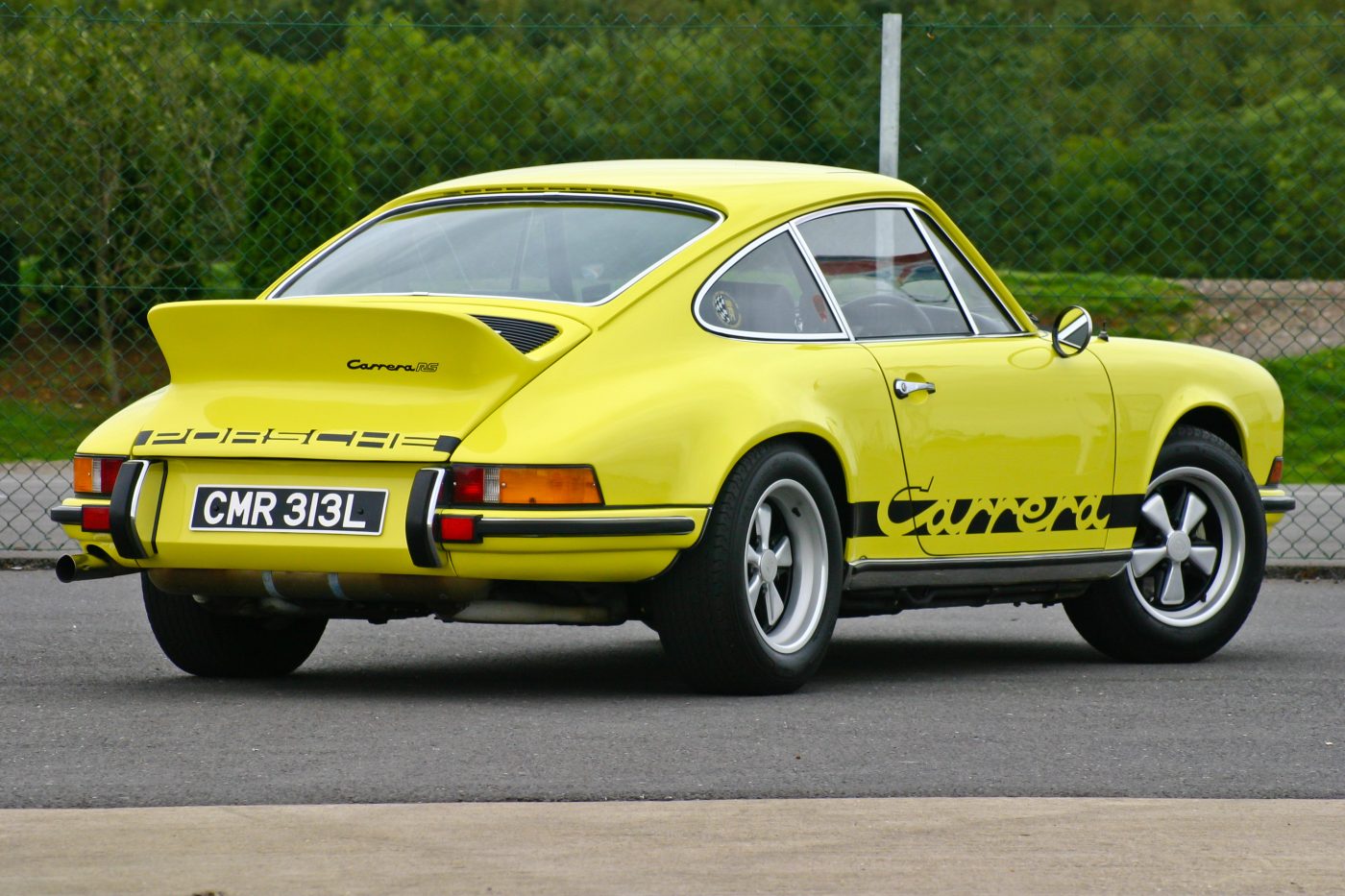
Common 1st Gen Porsche 911 Problems
What Buyers Should Know
When it comes to buying a first-generation Porsche 911, understanding the common issues is absolutely essential. These classic cars are now 50–60+ years old, and while they’re celebrated for their engineering purity and driving charm, they weren’t without quirks even when new—and time has only magnified many of those concerns. Below is an expert breakdown of the most common problems and what buyers should watch out for:
1. Rust: The Number One Killer
The most serious issue with early 911s is rust. These cars were not galvanized (Porsche didn’t start that until 1976), so they’re highly vulnerable to corrosion. Rust can occur in visible areas like the fenders and doors, but the structural rust is what really kills value and safety. Critical rust-prone areas include:
Suspension pickup points
Floorpans and battery boxes
Inner fenders, torsion tube mounts, and rocker panels
Front trunk floor and lower windshield corners
Many cars were poorly repaired in the past with patchwork or filler, so a magnet test or bore-scope inspection by a specialist is a must. Rust repair done right is expensive—budget five figures or more for a serious restoration.
2. Engine Issues: Wear, Oil Leaks, and Rebuilds
The early flat-six engines (2.0L to 2.4L) are robust but require regular care and proper rebuilds. Common problems include:
Oil Leaks: Expect some oil seepage, but excessive leaks from main seals, cam towers, or the oil cooler should be flagged.
Worn Valve Guides & Chain Tensioners: These wear with mileage and age. Many engines need top-end rebuilds by 100k miles.
Incorrect Rebuilds: A poorly rebuilt engine—using the wrong spec parts or tolerances—can lead to expensive rework.
Smoking on Cold Start: Some oil smoke is acceptable, but continuous smoking may point to worn rings or valve guides.
A comprehensive rebuild by a known specialist can run $15,000–$30,000+, so factor that into your purchase decision.
3. Transmission and Clutch Problems
Early 911s came with the “901” gearbox (dog-leg first gear) and later the 915. Both can be finicky:
Synchro Wear: Especially 2nd gear, which is the most used. Slow or grinding shifts may indicate the need for a rebuild.
Worn Linkages: Vague or notchy shifting may be due to worn bushings or improper adjustment.
Clutch Replacement: Clutches wear with age and hard use, and engine-out service is required.
A properly sorted gearbox feels mechanical but satisfying. A crunchy, balky box is a warning sign.
4. Electrical Gremlins and Aging Components
These cars use relatively simple, old-school electrics—but after 50+ years, issues arise:
Aging Wiring Looms: Brittle insulation can cause shorts or failures.
Corroded Grounds & Connectors: Particularly in high-moisture climates.
Dash Instruments: Tachs, speedos, and clocks often fail or drift. Rebuilding is possible, but not always cheap.
Starter/Ignition Issues: Weak starters or aging ignition switches can cause unreliable cold starts.
While most electrical issues are fixable, they’re time-consuming to track down and require expertise.
5. Suspension, Steering & Brake Wear
Original 911s are lightweight and mechanically simple, but suspension wear affects performance and feel:
Worn Bushings and Ball Joints: Leads to vague handling or odd clunks.
Tired Shocks and Torsion Bars: Ride quality and composure suffer.
Steering Box Issues: Looseness or dead spots are not normal.
Brake System Age: Soft pedal feel may come from tired master cylinders, old lines, or corroded calipers.
A fresh suspension setup makes an enormous difference in how these cars drive. Many owners upgrade subtly for better handling while preserving period-correct looks.
Final Thoughts: Buy With Eyes Wide Open
Buying a first-generation 911 is rarely just a casual purchase. These cars require expert inspection, deep documentation review, and clear alignment on your goals—driver, project, or collector. A well-sorted car can be a joy, a poor one can turn into a money pit. Use a specialist for a Pre-Purchase Inspection (PPI), budget for ongoing work, and be wary of “too cheap to be true” listings. When bought right, these early 911s offer unmatched charm, appreciation potential, and a driving experience that still feels connected and thrilling today.
Buying A Classic Porsche 911 (1st Generation) FAQs
Here are all the questions we've received from readers considering a 1965-1973 Porsche 911 for their garage
What to look for when buying an early 911 in terms of authenticity & documentation
When buying a first-generation Porsche 911 (1965–1973), verifying authenticity and documentation is absolutely critical—arguably just as important as mechanical condition or cosmetic appearance. These early 911s are highly collectible, and originality has a significant impact on both value and desirability. Here’s what you need to know:
Matching Numbers & Factory Documentation
The cornerstone of authenticity is whether the car has matching numbers—meaning the original engine and transmission installed by the factory are still in place. You’ll want to verify chassis number (VIN), which should match Porsche records and be consistent with the model year. You will want to look at the engine number, which on early cars is located on the engine case; check against COA or Kardex. Then finally, check the transmission number. Less often checked but also matters for top-tier collectors.
The best way to confirm these is to obtain a Certificate of Authenticity (COA) from Porsche or, even better, a Kardex document (a factory build sheet), which will list original paint color, engine, gearbox, and option codes. These documents help prove the car’s originality and can uncover red flags like color changes or engine swaps.
Paint, Trim & Option Codes
Originality goes beyond the drivetrain. Has the car been repainted or reupholstered? Is the interior correct for the model year and trim level? Factory options—such as sport seats, limited-slip differential, or special paint—can influence value, but only if well-documented. Enthusiasts and concours judges place a premium on factory-correct configurations.
Check under carpets, behind door panels, and in the engine bay for signs of original color, or clues that the car was modified or restored inconsistently. Collectors will pay more for cars that retain their factory specification and finishes—even if they show a bit of honest patina.
Ownership History & Provenance
A well-documented ownership history is another huge plus. Look for a chain of ownership going back decades (ideally to new). Obviously you want to see service records, receipts, and photos of any restoration work. We've found that one helpful thing to do is search for past sales listings or auction appearances since those documents and history are often shared in detail on those listing. A stack of documentation gives buyers peace of mind and helps tell the story of the car—especially important for rare models like the 911S, 911T Targa Soft Window, or early short-wheelbase (SWB) examples. For top-tier collector 911s, provenance can account for tens of thousands of dollars in value.
Final Tip
If you're looking at a potential purchase and authenticity is key, always budget for a Pre-Purchase Inspection (PPI) with a 911 expert who understands factory details, numbers-matching protocols, and period-correct features. On cars like these, documentation isn’t just paperwork—it’s part of the car’s DNA and directly tied to its collectible status.
Just how important are service records and ownership history?
When evaluating a first-generation Porsche 911—or any classic Porsche, for that matter—service records and ownership history are critically important, both from a buyer’s perspective and from a market valuation standpoint.
Why Service Records Matter
Service documentation tells the mechanical story of the car: what’s been done, when, and by whom. With cars as old as the 1965–1973 911s, this is essential because it helps distinguish a well-cared-for example from one that’s been neglected or poorly restored. Regular engine maintenance, valve adjustments, transmission rebuilds, rust prevention efforts, and even smaller details like carburetor tuning or Bosch MFI system servicing—these items all contribute to how the car performs today.
Moreover, the presence of invoices and records from known Porsche specialists (especially marque experts in vintage air-cooled cars) can significantly increase buyer confidence. Even for modified or restored cars, documented work helps verify that quality components and correct methods were used, rather than cheap shortcuts.
Why Ownership History Is Equally Important
A clear chain of ownership provides provenance, which matters tremendously for collector cars. This is especially true for rare variants—911S, 911T Soft Window Targa, or early short-wheelbase models. A car that has passed through a few careful, long-term owners, each of whom kept it garaged and maintained, is far more attractive than one with gaps in its history or years unaccounted for.
For serious buyers and collectors, long-term or single-family ownership adds credibility. In contrast, cars with incomplete histories raise concerns about potential accident damage, color changes, undocumented engine swaps, or mileage rollbacks.
Driver vs. Collector Perspective
If you’re buying a 911 as a fun weekend car—and not necessarily as a concours-level investment—then some leniency can be given to partial service records or modified examples. But even here, records remain important to understand the car’s mechanical health and what you might be inheriting in future repairs.
If you're shopping for a show-quality car or a long-term investment, complete documentation is non-negotiable. The top-dollar sales at auction and private sales are almost always accompanied by binders of receipts, a full ownership trail, and ideally a Porsche-issued Kardex or COA to back it all up.
In short: Documentation isn’t just “nice to have” with early 911s—it’s a powerful tool for verifying authenticity, planning future maintenance, and protecting your investment. Whether you're a driver or a collector, well-documented cars offer more peace of mind and, in nearly all cases, better long-term value.
Originality vs. Modified Early 911s: What’s More Valuable?
When it comes to early Porsche 911s (especially first-generation cars from 1965–1973), the debate between originality and modification is central to how a car is valued, appreciated, and used. Both have their merits, but depending on your goals—investment, driving pleasure, or collecting—one may be far more appropriate than the other.
Originality: The Gold Standard for Collectors
Unrestored or correctly restored 911s that retain their original paint colors, engine, transmission, trim, and factory options are the most desirable to collectors. These “time capsule” cars or “preservation class” vehicles often command a premium at auctions and among private buyers. Matching-numbers cars with a Porsche Certificate of Authenticity (COA) or Kardex record, especially those in rare colors or with special factory options, are often seen as blue-chip investments.
Original examples tend to appreciate more predictably over time, particularly the rare variants (e.g., early 911S, 911R, or short-wheelbase cars). For many enthusiasts and collectors, originality equals authenticity—and in the high-end market, provenance and preservation are king.
Modified Cars: More Fun, Less Fragile (and Often Cheaper)
That said, many buyers are not purists. Modified 911s—sometimes referred to as "outlaws"—offer performance and usability enhancements that make these classic cars more engaging or livable for spirited modern driving. Common upgrades include improved suspension, updated brakes, engine swaps or rebuilds for more power, modern lighting, bucket seats, and even full backdates or outlaw-style builds like those popularized by Singer and others.
For buyers who want a 911 to drive, not just collect, these modifications can make a car significantly more enjoyable and reliable—often at a lower initial purchase price than a pristine original example. However, resale values can be unpredictable, especially if modifications were not done to a high standard or are overly personalized.
Where the Market Currently Stands
The collector market continues to reward originality, particularly for high-end and rare models. However, there’s a healthy parallel market for well-done modified cars, especially those that are tastefully improved or built with a purpose (e.g., track use, rally spec, or restomod). If you’re investing, originality wins. If you’re driving, a modified example might be a better fit—and you’ll avoid the stress of rock chips on original paint or risking a rare drivetrain. That said, not all modifications are created equal: documented, professional work is key. A lightly modified, well-kept car with tasteful upgrades can still hold strong value—especially if the original parts are retained.
Final Verdict for Buyers
Buy original if you’re aiming for long-term appreciation, rarity, or concours events. Buy modified if your priority is driving pleasure, modern usability, or uniqueness—just make sure the work is well-documented and done right. Either way, due diligence on condition, records, and quality is non-negotiable. In the world of classic 911s, both originality and tasteful modification have passionate followings—you just have to decide which camp you're in.
What are the most sought after 1st Generation Porsche 911 variants?
Here are some of the most sought‑after variants of the first‑generation Porsche 911 (1965–1973), and what makes each special for collectors and enthusiasts.
1. Porsche 911S
The 911 S is widely considered the performance benchmark of the early 911s. With upgraded suspension, higher power, and the distinctive Fuchs alloy wheels first appearing in 1967, it holds a special place in Porsche lore. Its relative rarity compared to base models and the stronger performance credentials make the 911 S highly desirable. For many buyers it delivers the best blend of early 911 purity and performance.
2. Porsche 911E
The 911 E, with mechanical fuel injection (MFI) rather than carburettors, occupies a sweet spot in the early 911 range for those seeking a refined yet still raw driver’s car. It’s typically less expensive than the S but offers strong driveability and long‐term appeal. Because its performance is competitive and its usability better than some of the more extreme early models, the 911 E is growing in favour.
3. Early Short‑Wheelbase (SWB) models (1965–1968)
Even among the same model designations, the earliest short‑wheelbase (SWB) 911s are more desirable simply because of their age, chassis characteristics, rarity, and purity. These cars retain that lighter, more analog feel, which many purists prize. As the market recognizes that experiential difference, SWB examples command strong premiums.
4. Porsche 911 Carrera RS 2.7 (1973)
The Carrera RS 2.7 stands at the top in terms of desirability among this era of 911s. Built for homologation and featuring the iconic “ducktail” spoiler, lightweight construction, upgraded mechanics and just 2.7‑litre displacement, it has become the holy grail of early 911 ownership. It’s rare, historically significant, and demands the highest values accordingly.
5. Low‑production or special options (e.g., Targa Soft Window, Rare Colours)
Beyond the headline variants, there are special subset cars that draw strong interest: early Targa models with soft rear windows, cars in rare period factory colours, or those fitted with desirable factory options (e.g., sunroof delete, sport seats, Fuchs wheels). These examples often sit at the next tier of collectability because they offer originality and rarity.
In sum: if you’re looking for the most sought‑after early 911s, your priority list likely starts with the Carrera RS, followed by the 911 S, then the 911 E, especially in SWB form. From there, focus on rare specs, original condition, and provenance. Each step up in rarity, originality and performance brings a meaningful uplift in desirability—and value.
What are the underrated first gen Porsche 911 variants buyers should consider?
When selecting a first‑generation Porsche 911 (1965–1973), most buyers zero in on the headline models like the 911 S or the ultra‑rare Carrera RS 2.7. But there are several underrated variants that deserve serious consideration—especially if you’re seeking great driving experience, strong value, and future appeal without necessarily paying the top‑tier premium. Here are a few you should know about, and why they might make smart choices.
911 E (Mechanical Fuel Injection Models, 1969‑1971, later 2.4L in 1972‑73)
The 911 E often flies under the radar compared to the 911 S, but it offers a compelling blend of performance, usability, and relative value. With its Bosch mechanical fuel injection (MFI), the E delivers smoother throttle response, better mid‑range torque, and fewer carburettor setup headaches. Because it sat between the entry‑level T and performance S, it’s typically less expensive yet still highly authentic. Many enthusiasts consider the 911 E the sweet spot for those who want vintage 911 character, fewer compromises, and more everyday usability.
911 T (Especially 2.0‑2.2/2.4L LWB models, 1969‑1973)
The 911 T is often dismissed as the “entry‑level” early 911, but that’s turning around. When equipped with the long‑wheelbase (LWB) chassis (introduced 1969) and later 2.2‑/2.4‑litre engines, the 911 T becomes practical, reliable, and delightfully engaging. Because it’s less hyped, you can often buy one at a lower cost yet still enjoy the historic aura, air‑cooled flat‑six soundtrack, and that classic 911 silhouette. If you’re more driver‑oriented than collector‑obsessed, a clean 911 T might represent excellent value and future upside.
Targa Soft‑Window Models & Rare Factory Options
Within the 1965‑73 era, some variants stand out for their novelty rather than sheer performance. For example, early Targa models with the soft‑window rear (late‑1960s) are rarer and possess a unique charm. Likewise, cars built in rare Porsche factory colours, with less common factory options (sunroof delete, special interior trim, Fuchs wheels on lower trims) often offer hidden value. Such models may not command the same immediate attention as the S or RS, but discerning buyers are beginning to recognise their appeal—and the fact that fewer well‑preserved examples remain means good ones will likely become more collectible.
Why These Underrated Picks Make Sense
From an investment and usability standpoint, these models hit a sweet spot. They allow entry into the early 911 world at a more accessible price, allow you to drive and enjoy the car, and still retain strong heritage. Because they aren’t at the absolute top of the “collect‑it‑now” ladder, there’s less speculative premium built in, meaning potential for value appreciation without overpaying now. That balance—historic pedigree + more affordable entry + room to improve—is what makes them stand out.



